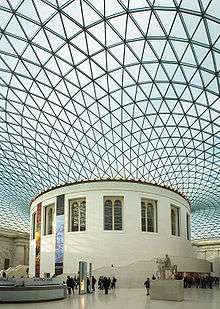Meroë Head
|
The bronze head of Augustus from Meroë on display in the British Museum | |
| Material | Bronze |
|---|---|
| Size | 46.2 cm high |
| Created | 27-25 BC |
| Present location | British Museum, London |
| Identification | 1911,0901.1 |
Discovery
The head was excavated by the British archaeologist John Garstang in December 1910 at Meroë, which had been the capital of the Kingdom of Kush for several centuries. The sculpture was found buried beneath a monumental stairway that lead to an altar of victory. This intended insult of burying the statue resulted in the head being well presented[3] after being buried for over 1900 years. The bust was donated to the British Museum by the Sudan Excavation Committee with the support of the National Art Collections Fund in 1911.[4]
Kushite raids
The head had clearly been hacked off a large statue made in honour of the Roman Emperor. The Greek historian Strabo mentions in his chronicles that numerous towns in Lower Egypt were adorned with statues of Augustus before an invading Kushite army looted many of them in 25 BC. Although the Roman military successfully invaded Kushite territory and reclaimed many statues, they were unable to reach as far south as the Kushite capital itself. The placing of the Emperor's head below the shrine's steps was clearly designed to symbolically denigrate the reputation of Augustus in the eyes of the Meroitic aristocracy.[5]
Description
The Meroë Head is larger than life size and mimics Greek art by portraying Augustus with classical proportions; it was clearly designed to idealise and flatter the Roman Emperor. Made of bronze, the eyes are inset with glass pupils and calcite irises. It is the preservation of the eyes (which are frequently lost in ancient bronze statues) which makes this statue so startlingly realistic. The emperor's head turns to his right and gazes powerfully into the distance. His hair falls onto his brow in waves that are typical of Augustus's portraits.[5] The British Museum has several other notable bronze heads of Roman Emperors including an image of Claudius. The heads are thought to have been made locally but based on moulds created in Rome.[5]
BBC series
The Meroë Head was the 35th object in A History of the World in 100 Objects, a BBC Radio 4 series first broadcast in 2010. The series traces the story of human civilisation through 100 iconic objects chosen from the collection of the British Museum.[3]
See also
References
| Wikimedia Commons has media related to Bronze head of Augustus (British Museum). |
- ↑ British Museum Highlights
- ↑ British Museum Collection
- 1 2 Meroë Head, BBC, retrieved 21 July 2014
- ↑ Image and portraiture of Augustus, the Meroë Head, CityLit.ac.uk, retrieved 21 July 2014
- 1 2 3 Head of Augustus, Transcipt of radio programme, retrieved 21 July 2014
Further reading
- D.E.L. Haynes,'The Date of the Bronze Head of Augustus from Meroe' in N. Bonacasa and A. Di Vita (eds), 'Alessandria e il mondo eltenistico- romano: studi in onore di Achille Adriani' (Rome 1983), pp. 177–81 (bibl.)
- D. Boschung, 'Die Bildnisse des Augustus' (Berlin 1993], pp. 160–1, no.122 (bibl.)
- S. Walker, Greek and Roman Portraits (London, The British Museum Press, 1995)
- S. Walker, Roman art (London, 1991)
- L. Burn, The British Museum book of Greek and Roman Art, revised edition (London, The British Museum Press, 1999)
| Preceded by 34: Han lacquer cup |
A History of the World in 100 Objects Object 35 |
Succeeded by 36: The Warren Cup |
